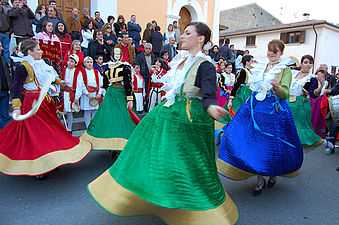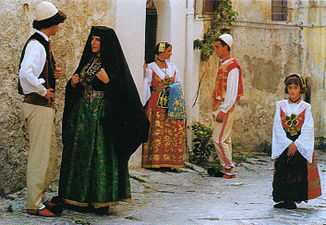Albanians
| ||||||||||||||||||||||||||
| Total population | ||||||||||||||||||||||||||
|---|---|---|---|---|---|---|---|---|---|---|---|---|---|---|---|---|---|---|---|---|---|---|---|---|---|---|
| 7,5-13 million [note 1] | ||||||||||||||||||||||||||
| Regions with significant populations | ||||||||||||||||||||||||||
|
| ||||||||||||||||||||||||||
| Europe | ca. 8 million | |||||||||||||||||||||||||
| 1,300,000-5,000,0002[3][4] | ||||||||||||||||||||||||||
| 509,083 (2002)[5] | ||||||||||||||||||||||||||
| 502,546[6]–800,0001[7][8] | ||||||||||||||||||||||||||
| 300,000[9] | ||||||||||||||||||||||||||
| 280,000[10][11] | ||||||||||||||||||||||||||
| 200,000[12][13] | ||||||||||||||||||||||||||
| 50,000-70,000[14][15][16][17] | ||||||||||||||||||||||||||
| 54,000[18] | ||||||||||||||||||||||||||
| 30,439[19] | ||||||||||||||||||||||||||
| 30,000[20] | ||||||||||||||||||||||||||
| 28,212[21] | ||||||||||||||||||||||||||
| 20,000[22] | ||||||||||||||||||||||||||
| 17,513 (2011)[23] | ||||||||||||||||||||||||||
| 10,000[24] | ||||||||||||||||||||||||||
| 5,000-20,000 | ||||||||||||||||||||||||||
| 10,000 | ||||||||||||||||||||||||||
| 8,223[25] | ||||||||||||||||||||||||||
| 8,214[26] | ||||||||||||||||||||||||||
| 5,600–30,000[27][28] | ||||||||||||||||||||||||||
| 5,000[29] | ||||||||||||||||||||||||||
| 4,020[30] | ||||||||||||||||||||||||||
| Rest of World: | ca. 1 million | |||||||||||||||||||||||||
| 193,813[31] | ||||||||||||||||||||||||||
| 28,270[32] | ||||||||||||||||||||||||||
| 18,000[33] | ||||||||||||||||||||||||||
| 11,315[34] | ||||||||||||||||||||||||||
| Languages | ||||||||||||||||||||||||||
|
Albanian (Gheg and Tosk Dialects) | ||||||||||||||||||||||||||
| Religion | ||||||||||||||||||||||||||
|
| ||||||||||||||||||||||||||
|
1 502,546 Albanian citizens, an additional 43,751 Kosovo Albanians and 260,000 Arbëreshë people)[7][8][35] | ||||||||||||||||||||||||||
| Part of a series on |
| Albanians |
|---|
 |
| Nation |
| Communities |
|
| Subgroups |
| Albanian culture |
| Albanian language |
|
|
| Religion |
| History |
Albanians (Albanian: Shqiptarët) are defined as an ethnic group native to Albania and neighboring countries. The term is also used sometimes to refer to the citizens of the Republic of Albania regardless of ethnicity.[36] Ethnic Albanians speak the Albanian language and more than half of ethnic Albanians live in Albania and Kosovo.[lower-alpha 1] The Albanian diaspora also exists in a number of other countries.
Ethnonym
The ethnonym Albanians is believed to be derived from Albanoi,[37][38][39] an Illyrian tribe mentioned by Ptolemy in the city of Albanopolis. While the exonym Albania for the general region inhabited by the Albanians does hark back to Classical Antiquity, the Albanian language employs a different ethnonym, with modern Albanians referring to themselves as shqipëtarë and to their country as Shqipëria. Two etymologies have been conjectured for this ethnonym: one, associated with Maximilian Lambertz, derives the etymology from the Albanian for eagle (shqipe, var.,shqiponjë), perhaps denoting denizens of a mountainous region. In Albanian folk etymology, this word denotes a bird totem dating from the times of Skanderbeg, as displayed on the Albanian flag.[40] The other suggestion connects it to the verb 'to speak' (me shqiptue).[41][42] If the latter conjecture were correct, the Albanian endonym, like Slav and others, would originally have been a term for "those who speak [intelligibly, the same language]".
In History written in 1079–1080, the Byzantine historian Michael Attaliates referred to the Albanoi as having taken part in a revolt against Constantinople in 1043 and to the Arbanitai as subjects of the duke of Dyrrachium. It is disputed, however, whether that refers to Albanians in an ethnic sense.[43] However a later reference to Albanians from the same Attaliates, regarding the participation of Albanians in a rebellion around 1078, is undisputed.[44] In later Byzantine usage, the terms "Arbanitai" and "Albanoi", with a range of variants, were used interchangeably, while sometimes the same groups were also called by the classicising names Illyrians.[45][46][47] The first reference to the Albanian language dates to the later 13th century (around 1285).[48]
The Albanians are and have been referred to by other terms as well. Some of them are:
- Arbër, Arbën, Arbëreshë; the old native term denoting ancient and medieval Albanians and sharing the same root with the latter. At the time the country was called Arbër (Gheg: Arbën) and Arbëria (Gheg: Arbënia). This term is still used for the Albanians that migrated to Italy during the Middle Ages.
- Arnauts (ارناود); old term used mainly from Turks and by extension by European authors during the Ottoman Empire. A derivate of the Turkish Arvanid (Arnavut) (اروانيد), which derives from the Greek Arvanites.
- Skipetars; the historical rendering of the ethnonym Shqiptar (or Shqyptar by French, Austrian and German authors) in use from the 18th century (but probably earlier) to the present, the literal translation of which is subject of the eagle. The term Šiptari is a derivation used by Yugoslavs which the Albanians consider derogatory, preferring Albanci instead.
History
Studies in genetic anthropology show that the Albanians share the same ancestry as most other European peoples.[49]
Albanians in the Middle Ages
What is possibly the earliest written reference to the Albanians is that to be found in an old Bulgarian text compiled around the beginning of the 11th century.[50] It was discovered in a Serbian manuscript dated 1628 and was first published in 1934 by Radoslav Grujic. This fragment of a legend from the time of Tsar Samuel endeavours, in a catechismal 'question and answer' form, to explain the origins of peoples and languages. It divides the world into seventy-two languages and three religious categories: Orthodox, half-believers (i.e. non-Orthodox Christians) and non-believers. The Albanians find their place among the nations of half-believers. If the dating of Grujic is accepted, which is based primarily upon the contents of the text as a whole, this would be the earliest written document referring to the Albanians as a people or language group.[51]
It can be seen that there are various languages on earth. Of them, there are five Orthodox languages: Bulgarian, Greek, Syrian, Iberian (Georgian) and Russian. Three of these have Orthodox alphabets: Greek, Bulgarian and Iberian. There are twelve languages of half-believers: Alamanians, Franks, Magyars (Hungarians), Indians, Jacobites, Armenians, Saxons, Lechs (Poles), Arbanasi (Albanians), Croatians, Hizi, Germans.
The first undisputed mention of Albanians in the historical record is attested in Byzantine source for the first time in 1079–1080, in a work titled History by Byzantine historian Michael Attaliates, who referred to the Albanoi as having taken part in a revolt against Constantinople in 1043 and to the Arbanitai as subjects of the duke of Dyrrachium. It is disputed, however, whether the "Albanoi" of the events of 1043 refers to Albanians in an ethnic sense or whether "Albanoi" is a reference to Normans from Sicily under an archaic name (there was also tribe of Italy by the name of "Albanoi").[52] However a later reference to Albanians from the same Attaleiates, regarding the participation of Albanians in a rebellion around 1078, is undisputed.[44] At this point, they are already fully Christianized, although Albanian mythology and folklore are part of the Paleo-Balkan pagan mythology,[53] in particular showing Greek influence.[54]
From late 11th century the Albanians were called Arbën/Arbër and their country as Arbanon,[55] a mountainous area to the west of Lake Ochrida and the upper valley of the river Shkumbin.[56] It was in 1190, when the rulers of Arbanon (local Albanian noble called Progon and his sons Dhimitër and Gjin) created their principality with its capital at Krujë.[57] After the fall of Progon Dynasty in 1216, the principality came under Grigor Kamona and Gulam of Albania. Finally the Principality was dissolved on 1255. Around 1230 the two main centers of Albanian settlements, one around Devoll river in what is now central Albania,[58] and the other around the region which was known with the name Arbanon.[59]
In 1271 Charles of Anjou after he captured Durrës from Despotate of Epirus, created the Kingdom of Albania. In the 14th century a number of Albanian principalities were created.
-
.png)
Location of Arbanon in the 11th century. According to Ducellier the castle of Petrela was the access point to the region known with this name[1]
-
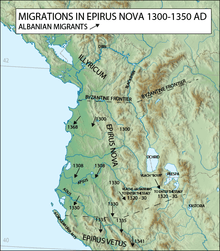
Population movements, 14th century.
- ^ L'Albanie entre Byzance et Venise" Volume 248 of Collected studies Variorum Collected Studies Volume 248 of Variorum reprint Author Alain Ducellier Edition illustrated, reprint Publisher Variorum Reprints, 1987 ISBN 0-86078-196-8, ISBN 978-0-86078-196-7. "Par deux fois, Anne Comnene laisse entendre que la place forte de Petrela constitue la voie d'acces principale de cette region ..."
Albanians under the Ottoman Empire

At the dawn of the establishment of the Ottoman Empire in Southeast Europe, the geopolitical landscape was marked by scattered kingdoms of small principalities. The Ottomans erected their garrisons throughout southern Albania by 1415 and established formal jurisdiction over most of Albania by 1431.[60] However, on 1443 a great and longstanding revolt broke under the lead of the Albanian national hero Skanderbeg, which lasted until 1479, many times defeating major Ottoman armies led by sultans Murad II and Mehmed II. Skanderbeg united initially the Albanian princes and later established a centralized authority over most of the non-conquered territories, becoming Lord of Albania. He also tried relentlessly but rather unsuccessfully to create a European coalition against the Ottomans. He frustrated every attempt by the Turks to regain Albania, which they envisioned as a springboard for the invasion of Italy and western Europe. His unequal fight against the mightiest power of the time won the esteem of Europe as well as some support in the form of money and military aid from Naples, the papacy, Venice, and Ragusa.[61] Finally after decades of resistance, Ottomans captured Shkodër in 1479 and Durrës in 1501.[62] Skanderbeg’s long struggle to keep Albania free became highly significant to the Albanian people, as it strengthened their solidarity, made them more conscious of their national identity, and served later as a great source of inspiration in their struggle for national unity, freedom, and independence.[61][63] The invasion triggered a several waves of migration of Albanians from Albania, Epir and Peoponesse to the south of Italy, constituting an Arbereshe community. Albanians were recruited all over Europe as a light cavalry known as stratioti. The stratioti were pioneers of light cavalry tactics during this era. In the early 16th century heavy cavalry in the European armies was principally remodeled after Albanian stradioti of the Venetian army, Hungarian hussars and German mercenary cavalry units (Schwarzreitern).[64] By the 16th century, Ottoman rule over Southeast Europe was largely secure. The Ottomans proceeded in stages, first appointing a qadi along with governors and then military retainers in the cities. Timar holders, not necessarily converts to Islam, would occasionally rebel, the most famous case of which is Skanderbeg. His figure would be used later in the 19th century as a central component of Albanian national identity. Ottoman control over the Albanian territories was secured in 1571 when Ulcinj, presently in Montenegro, was captured. The most significant impact on the Albanians was the gradual Islamisation process of a large majority of the population- although such a process only became widespread in the 17th century.[65] Mainly Catholics converted in the 17th century, while the Orthodox Albanians became Muslim mainly in the following century. Initially confined to the main city centres of Elbasan and Shkodër, by this time the countryside was also embracing the new religion.[65] In Elbasan Muslims made up just over half the population in 1569–70 whereas in Shkodër this was almost 90% and in Berat closer to 60%. In the 17th century, however, Catholic conversion to Islam increased, even in the countryside. The motives for conversion according to scholars were diverse, depending on the context. The lack of source-material does not help when investigating such issues.[65] Albanians could also be found across the empire, in Egypt, Algeria, and across the Maghreb as vital military and administrative retainers.[66]
Albanian national awakening
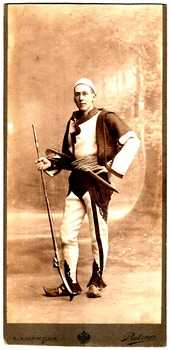
By the 1870s, the Sublime Porte's reforms aimed at checking the Ottoman Empire's disintegration had clearly failed. The image of the "Turkish yoke" had become fixed in the nationalist mythologies and psyches of the empire's Balkan peoples, and their march toward independence quickened. The Albanians, because of the higher degree of Islamic influence, their internal social divisions, and the fear that they would lose their Albanian-populated lands to the emerging Balkan states—Serbia, Montenegro, Bulgaria, and Greece—were the last of the Balkan peoples to desire division from the Ottoman Empire.[67] The Albanian national awakening as a coherent political movement began after the Treaty of San Stefano, according to which Albanian-inhabited areas were to be ceded to other states of the Balkans, and focused on preventing that partition.[68][69] The Treaty of San Stefano was the impetus for the nation-building movement, which was based more on fear of partition than national identity.[69] Even after Albania became independent in 1912, Albanian national identity was fragmented and possible non-existent in much of the new country.[69] The state of disunity and fragmentation would remain until the communist period following World War II, when the communist nation-building project would achieve greater success in nation-building and reach more people than any previous regime, thus creating Albanian national communist identity.[69]
Distribution

Southeast Europe
Approximately 7 million Albanians are to be found within the Balkan peninsula with about half this number residing in Albania and the other divided between Kosovo, Montenegro, Serbia, the Republic of Macedonia, Greece and to a much smaller extent Bosnia, Bulgaria, Croatia, Romania, and Slovenia.
Albania
Albania has an estimated 3 million inhabitants, with ethnic Albanians comprising approximately 95% of the total.[70]
Former Yugoslavia
An estimated 2.2 million Albanians live in the territory of Former Yugoslavia, the greater part (close to two million) in Kosovo.[lower-alpha 1]
Rights to use the Albanian language in education and government were given and guaranteed by the 1974 Constitution of SFRY and were widely utilized in Macedonia and in Montenegro before the Dissolution of Yugoslavia.[71]
Greece
An estimated 275,000–600,000 Albanians live in Greece, forming the largest immigrant community in the country. They are economic migrants whose migration began in 1991, following the collapse of the Socialist People's Republic of Albania.
The Arvanites and Albanian-speakers of Western Thrace are a group descended from Tosks who migrated to southern and central Greece between the 13th and 16th centuries. They are Greek Orthodox Christians, and though they traditionally speak a dialect of Tosk Albanian known as Arvanitika, they have fully assimilated into the Greek nation and do not identify as Albanians. Arvanitika is in a state of attrition due to language shift towards Greek and large-scale internal migration to the cities and subsequent intermingling of the population during the 20th century.
The Cham Albanians were a group that formerly inhabited a region of Epirus known as Chameria, nowadays Thesprotia in northwestern Greece. Most Cham Albanians converted to Islam during the Ottoman era. Muslim Chams were expelled from Greece during World War II, by an anti-communist resistance group, as a result of their participation in a communist resistance group and the collaboration with the Axis occupation, while Orthodox Chams have largely assimilated into the Greek nation.
Diaspora

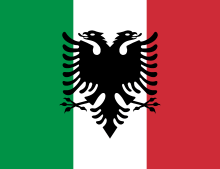
Europe
Approximately 1 million are dispersed throughout the rest of Europe, most of these in Italy (502,546), Germany (320,000), Switzerland (200,000), Sweden (60,000), and the UK.
Italy has a historical Albanian minority known as the Arbëreshë (260,000) which are scattered across Southern Italy, but the majority of Albanians in Italy arrived in 1991 and have since surpassed the older populations of Arbëreshë.
Turkey
According to a 2008 report prepared for the National Security Council of Turkey by academics of three Turkish universities in eastern Anatolia, there were approximately 1,300,000 people of Albanian descent living in Turkey.[72] A part of these people have assimilated to the culture of Turkey, and consider themselves more Turkish than Albanian. Nonetheless, more than 500,000 Albanian descendants still recognize their ancestry like their languages, culture and traditions.
Egypt
In Egypt there are 18,000 Albanians, mostly Tosk speakers. Many are descendants of the Janissary of Muhammad Ali Pasha, an Albanian who became Wāli, and self-declared Khedive of Egypt and Sudan. In addition to the dynasty that he established, a large part of the former Egyptian and Sudanese aristocracy was of Albanian origin. Albanian Sunnis, Bektashis and Orthodox Christians were all represented in this diaspora, whose members at some point included major Renaissance figures (Rilindasit), including Fan Noli who lived in Egypt for a time. With the ascension of Gamal Abdel Nasser in Egypt and his ideology of Arab nationalism, the last remnants of Albanian community there were forced to leave.[73]
Overseas
According to the 2010 American Community Survey, there are 193,813 Albanian Americans (American citizens of full or partial Albanian descent).[31]
In Australia and New Zealand there are a total of 22,000 Albanians. Albanians are also known to reside in China, India, Iran, Japan, Korea, Malaysia, Pakistan and Singapore, but the numbers are generally small. Albanians have been present in Arab countries such as Iraq, Jordan, Lebanon and Syria for about five centuries as a legacy of Ottoman Turkish rule.
Language
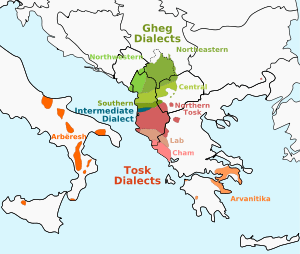
The Albanian language forms a separate branch of the Indo-European languages family tree. A traditional view, based mainly on the territory where the languages were spoken, links the origin of Albanian with Illyrian. Not enough Illyrian archaeological evidence is left behind however, to come to a definite conclusion. Another theory links the Albanian as originating from the Thracian language: however this theory takes exception to the territory, since the Thracian language was spoken in an area distinct from Albania, and no significant population movements have been recorded in the period when the shift from one language to the other is supposed to have occurred.[74]
Albanian in a revised form of the Tosk dialect is the official language of Albania and Kosovo;[lower-alpha 1] and is official in the municipalities where there are more than 20% ethnic Albanian inhabitants in the Republic of Macedonia. It is also an official language of Montenegro where it is spoken in the municipalities with ethnic Albanian populations.
Religion
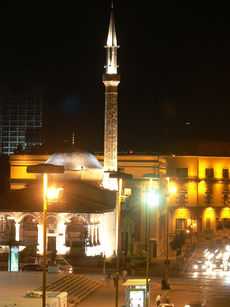
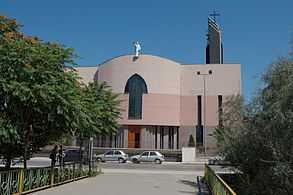
The Albanians first appear in the historical record in Byzantine sources of the late 11th century.[75] At this point, they were already fully Christianized. All Albanians were Orthodox Christians until the middle of the 13th century when the Ghegs were converted to Catholicism as a mean to resist the Slavs.[76][77][78] Christianity was later overtaken by Islam, which kept the scepter of the major religion during the period of Ottoman Turkish rule from the 15th century until 1912. Eastern Orthodox Christianity and Roman Catholicism continued to be practiced with less frequency.
During the 20th century the monarchy and later the totalitarian state followed a systematic secularization of the nation and the national culture. This policy was chiefly applied within the borders of the current Albanian state. It produced a secular majority in the population. All forms of Christianity, Islam and other religious practices were prohibited except for old non-institutional pagan practices in the rural areas, which were seen as identifying with the national culture. The current Albanian state has revived some pagan festivals, such as the Spring festival (Albanian: Dita e Verës) held yearly on March 14 in the city of Elbasan. It is a national holiday.
According to 2011 census, 58.79% of Albania adheres to Islam, making it the largest religion in the country. The majority of Albanian Muslims are Secular Sunni with a significant Bektashi Shia minority. Christianity is practiced by 16.99% of the population, making it the second largest religion in the country. The remaining population is either irreligious or belongs to other religious groups.[79] Before World War II, there was given a distribution of 70% Muslims, 20% Eastern Orthodox, and 10% Roman Catholics.[80] Today, Gallup Global Reports 2010 shows that religion plays a role in the lives of only 39% of Albanians, and ranks Albania the thirteenth least religious country in the world.[81]
The results of the 2011 census, however, have been criticized as questionable on a number of grounds, and have been said to drastically underrepresent the number of Orthodox, Bektashi and irreligious Albanians, with problems including whole communities reporting that they had not been contacted, workers filling out questions without even asking the respondents and a drastic difference between the final results and the preliminary results with regard to religion (which showed over 70% declining to answer the question about religion).[82][83][84][85][86][87][88][89]
The Communist regime that took control of Albania after World War II persecuted and suppressed religious observance and institutions and entirely banned religion to the point where Albania was officially declared to be the world's first atheist state. Religious freedom has returned to Albania since the regime's change in 1992. Albanian Muslim populations (mainly secular and of the Sunni branch) are found throughout the country whereas Albanian Orthodox Christians as well as Bektashis are concentrated in the south; Roman Catholics are found primarily in the north of the country.[90]
For part of its history, Albania has also had a Jewish community. Members of the Jewish community were saved by a group of Albanians during the Nazi occupation.[91] Many left for Israel c. 1990 – 1992 after borders were open due to fall of communist regime in Albania, while in modern times about 200 Albanian Jews still live in Albania.
| Religion | Albania | Kosovo | Albanians in Macedonia | Albanians in Montenegro | Albanians in Croatia | |||||
|---|---|---|---|---|---|---|---|---|---|---|
| Population | % | Population | % | Population | % | Population | % | Population | % | |
| Islam Sunni Bektashi | 1,646,236 1,587,608 58,628 | 58.79 56.70 2.09 | 1,663,412 — — | 95.60 — — | 502,075 — — | 98.62 — — | 22,267 — — | 73.15 — — | 9,594 — — | 54.78 — — |
| Christians Catholic Orthodox Evangelists Other Christians | 475,629 280,921 188,992 3,797 1,919 | 16.99 10.03 6.75 0.14 0.07 | 64,275 38,438 25,837 — — | 3.69 2.20 1.48 — — | 7,008 7,008 — — — | 1.37 1.37 — — — | 8,027 7,954 37 — 36 | 26.37 26.13 0.12 — 0.12 | 7,126 7,109 2 — 15 | 40.69 40.59 0.01 — 0.09 |
| Atheist | 69,995 | 2.50 | 1,242 | 0.07 | — | — | 35 | 0.11 | 316 | 1.80 |
| Prefer not to answer | 386,024 | 13.79 | 9,708 | 0.55 | — | — | 58 | 0.19 | 414 | 2.36 |
| Believers without denomination | 153,630 | 5.49 | — | — | — | — | — | — | — | — |
| Not relevant/not stated | 68,022 | 2.43 | 1,188 | 0.06 | — | — | 48 | 0.16 | 63 | 0.36 |
Culture
| Part of a series on |
| Indo-European topics |
|---|
|
|
Philology
|
|
Origins
|
|
Archaeology |
|
Peoples and societies
|
|
Religion and mythology |
Albanian folk music displays a variety of influences. Albanian folk music traditions differ by region, with major stylistic differences between the traditional music of the Ghegs in the north and Tosks in the south. Modern popular music has developed around the centers of Korca, Shkodër and Tirana. Since the 1920s, some composers such as Fan S. Noli have also produced works of Albanian classical music.
Notable Albanians
- Skanderbeg – 15th-century Albanian lord, leader of the League of Lezhë
- Ismail Qemali - Founder of the Independent Albania
- Lorik Cana – football player
- Isa Boletini - Albanian nationalist
- Agim Kaba – Emmy-nominated actor and artist
- Dritëro Agolli – poet, writer
- Eliza Dushku – American actor
- Ernesto Sabato (1911–2011) – Argentinian writer, painter and physicist of Arbëreshë descent
- Gjon Buzuku – Catholic cleric; author of the first book written in Albanian
- Gjon Mili – Albanian-American photographer
- Ibrahim Rugova – ex president of Kosovo
- Inva Mula – opera soprano
- Ismail Kadare – writer
- James Biberi – actor
- Jim Belushi – American actor and comedian
- John Belushi – American actor and comedian
- Karl Gega – architect
- Adnan Januzaj – football player
- Mohammed Ali Pasha – Viceroy of Egypt and Sudan
- Mother Teresa – beatified Catholic nun
- Muhammad Nasiruddin al-Albani – Islamic scholar
- Naim Kryeziu – football player
- Rexhep Qosja – Albanian politician and literary critic
- Rita Ora – British singer
- Sedefkar Mehmed Agha – architect of the Sultan Ahmed Mosque (the "Blue Mosque") in Istanbul
- Viktor Karpaçi – painter of Renaissance
- Aleksander Moisiu – stage actor
- Ali Sami Yen 20 May 1886 – 29 July 1951 – founder of the Galatasaray Sports Club
- Mit’hat Frashëri – Albanian diplomat, writer and politician
- Ali Pasha of Tepelena - Albanian ruler
- Zog I of Albania - King of Albania
Gallery
See also
- Albanian American
- Albanian diaspora
- Albanians in Ukraine
- Albanoi
- Arbanasi (group)
- Arbëreshë
- Arvanites
- Cham Albanians
- Demographics of Albania
- EURALIUS
- List of Albanian-Americans
- List of Albanians
- Mandritsa
Notes
- ↑ The totals are obtained as the sum of the referenced populations (lowest and highest figures) below in the infobox.
Footnotes
- ↑ 1.0 1.1 1.2 1.3 Kosovo is the subject of a territorial dispute between the Republic of Serbia and the Republic of Kosovo. The latter declared independence on 17 February 2008, but Serbia continues to claim it as part of its own sovereign territory. Kosovo's independence has been recognised by 108 out of 193 United Nations member states.
Further reading
- Edith Durham. The Burden of the Balkans,[92] (1905)
Citations
- ↑ "Main Results of Population and Housing Census 2011". INSTAT. Retrieved 24 December 2013.
- ↑ See 2011 Census, the preliminary results of the 2011 census in the Republic of Kosovo show the national population at 1,733,872 but the census was boycotted in North Kosovo and this figure does not include the entire population of Kosovo. The 2011 census revealed a figure of 1,616,869 people declaring as Albanians).
- ↑ "Türkiye'deki Kürtlerin sayısı!" (in Turkish). 6 June 2008. Retrieved 17 August 2010.
- ↑ 4.0 4.1 https://books.google.al/books?id=-7dq8mi0DWkC&pg=PA38&lpg=PA38&dq=5+million+albanians+in+turkey&source=bl&ots=_998M5uAPE&sig=KIYpZ3fp9IWouHunaZBrUBt-fT4&hl=en&sa=X&ei=i6_bVMidFoqtUYySg5AE&ved=0CFEQ6AEwCA#v=onepage&q=5%20million%20albanians%20in%20turkey&f=false
- ↑ "2002 Macedonian Census" (PDF). Archived (PDF) from the original on 22 September 2010. Retrieved 22 September 2010.
- ↑ "Cittadini non comunitari regolarmente presenti". istat.it. Retrieved 3 October 2014.
- ↑ 7.0 7.1 "Kosovari in Italia".
- ↑ 8.0 8.1 Albanian, Arbëreshë - A language of Italy - Ethnic population: 260,000 (Stephens 1976).
- ↑ Hans-Peter Bartels: Deutscher Bundestag - 16. Wahlperiode - 166. Sitzung. Berlin, Donnerstag, den 5. Juni 2008
- ↑ "Announcement of the demographic and social characteristics of the Resident Population of Greece according to the 2011 Population - Housing Census." [Graph 7 Resident population with foreign citizenship] (PDF). Greek National Statistics Agency. 23 August 2013. Retrieved 3 June 2014.
- ↑ Waldrauch, edited by Rainer Bauböck, Eva Ersboll, Kees Groenendijk, Harald (2006). Comparative analyses ([Online-Ausg.]. ed.). Amsterdam: Amsterdam Univ. Press. p. 416. ISBN 9789053569207.
approximately 200,000 of these immigrants have been granted the status of homogeneis
- ↑ "Die Albaner in der Schweiz: Geschichtliches – Albaner in der Schweiz seit 1431" (PDF). Retrieved 22 September 2010.
- ↑ "Im Namen aller Albaner eine Moschee?". Infowilplus.ch. 2007-05-25. Retrieved 22 September 2010.
- ↑ "South Serbia Albanians Seek Community of Municipalities". Retrieved 17 July 2013.
South Serbia is home to 50,000 or so Albanians.
- ↑ Partos, Gabriel (2 February 2001). "Presevo valley tension". BBC. Retrieved 14 January 2015.
Initially, the guerrillas' publicly acknowledged objective was to protect the local ethnic Albanian population of some 70,000 people from the repressive actions of the Serb security forces.
- ↑ "The Presevo Valley of Southern Serbia alongside Kosovo The Case for Decentralisation and Minority Protection" (PDF). Retrieved 24 October 2013.
The total population of the Valley is around 86,000 inhabitants of whom around 57,000 are Albanians and the rest are Serbs and Roma
- ↑ "Yugoslavia: Serbia Offers Peace Plan For Presevo Valley". Retrieved 24 October 2013.
The Serbian peace proposal calls for integrating the Presevo valley's 70,000 ethnic Albanian residents into mainstream Serbian political and social life.
- ↑ "Total Population of Albanians in the Sweden".
- ↑ "Official Results of Monenegrin Census 2011" (PDF). Retrieved 24 December 2013.
- ↑ Bennetto, Jason (2002-11-25). "Total Population of Albanians in the United Kingdom". London: Independent.co.uk. Retrieved 22 September 2010.
- ↑ "Statistik Austria". Statistik.at. Retrieved 24 December 2013.
- ↑ http://www.insee.fr/fr/themes/theme.asp?theme=2&sous_theme=5
- ↑ "Population by Ethnicity, by Towns/Municipalities, 2011 Census". Census of Population, Households and Dwellings 2011. Zagreb: Croatian Bureau of Statistics. December 2012.
- ↑ "Date demografice" (in Romanian). Archived from the original on 11 August 2010. Retrieved 18 August 2010.
- ↑ "National statistics of Denmark". Dst.dk. Archived from the original on 26 September 2010. Retrieved 22 September 2010.
- ↑ "Demographics of Finland".
- ↑ "Population par nationalité, sexe, groupe et classe d'âges au 1er janvier 2010" (in French). Retrieved 12 January 2012.
- ↑ "Anderlecht, Molenbeek, Schaarbeek: repères du crime à Bruxelles". cafebabel.com. Retrieved 12 January 2012.
- ↑ Olson, James S., An Ethnohistorical Dictionary of the Russian and Soviet Empires. (Westport: Greenwood Press, 1994) p. 28–29
- ↑ "Slovenia: Languages (Immigrant Languages)".
- ↑ 31.0 31.1 "Total ancestry categories tallied for people with one or more ancestry categories reported 2010 American Community Survey 1-Year Estimates". United States Census Bureau. Retrieved 30 November 2012.
- ↑ "Ethnic Origin (264), Single and Multiple Ethnic Origin Responses (3), Generation Status (4), Age Groups (10) and Sex (3) for the Population in Private Households of Canada, Provinces, Territories, Census Metropolitan Areas and Census Agglomerations, 2011 National Household Survey".
- ↑ "Egypt: Languages (Immigrant Languages)".
- ↑ "20680-Ancestry (full classification list) by Sex - Australia" (MICROSOFT EXCEL DOWNLOAD). 2006 Census. Australian Bureau of Statistics. Retrieved 2 June 2008. Total responses: 25,451,383 for total count of persons: 19,855,288.
- ↑ Ethnobotany in the New Europe: People, Health and Wild Plant Resources, vol. 14, Manuel Pardo de Santayana, Andrea Pieroni, Rajindra K. Puri, Berghahn Books, 2010, ISBN 1845458141, p. 18.
- ↑ Gëzim Krasniqi. "Citizenship in an emigrant nation-state: the case of Albania" (PDF). University of Edinburgh. Retrieved 7 August 2012.
- ↑ History of the Byzantine Empire, 324–1453 By Alexander A. Vasiliev Edition: 2, illustrated Published by Univ of Wisconsin Press, 1958 ISBN 0-299-80926-9, ISBN 978-0-299-80926-3 (page 613)
- ↑ History of the Balkans: Eighteenth and nineteenth centuries By Barbara Jelavich Edition: reprint, illustrated Published by Cambridge University Press, 1983 ISBN 0-521-27458-3, ISBN 978-0-521-27458-6 (page 25)
- ↑ The Indo-European languages By Anna Giacalone Ramat, Paolo Ramat Edition: illustrated Published by Taylor & Francis, 1998 ISBN 0-415-06449-X, 9780415064491 (page 481)
- ↑ "ALBANCI". Enciklopedija Jugoslavije 2nd ed. Supplement. Zagreb: JLZ. 1984. p. 1.
- ↑ Robert Bideleux, Ian Jeffries,The Balkans: A Post-Communist History, Routledge 2006 p.26.
- ↑ The theory linking the ethnoym to the verb 'to speak' was advanced by Hahn who suggested it was perhaps a Latin loan word from excipio. See Robert Elsie, A dictionary of Albanian religion, mythology and folk culture, C. Hurst & Co. Publishers, 2001, ISBN 978-1-85065-570-1, p. 79.
- ↑ Pritsak, Omeljan (1991). "Albanians". Oxford Dictionary of Byzantium 1. New York/Oxford: Oxford University Press. pp. 52–53.
- ↑ 44.0 44.1 The wars of the Balkan Peninsula: their medieval origins G – Reference, Information and Interdisciplinary Subjects Series Authors Alexandru Madgearu, Martin Gordon Editor Martin Gordon Translated by Alexandru Madgearu Edition illustrated Publisher Scarecrow Press, 2008 ISBN 0-8108-5846-0, ISBN 978-0-8108-5846-6 It was supposed that those Albanoi from 1042 were Normans from Sicily, called by an archaic name (the Albanoi were an independent tribe from Southern Italy). The following instance is indisputable. It comes from the same Attaliates, who wrote that the Albanians (Arbanitai) were involved in the 1078; rebellion of... p. 25
- ↑ Mazaris 1975, pp. 76–79.
- ↑ N. Gregoras (ed. Bonn) V, 6; XI, 6.
- ↑ Finlay, G. (1851). The History of Greece: From Its Conquest by the Crusaders to Its Conquest by the Turks, and of the Empire of Trebizond: 1204-1461. Blackwood. p. 37. Retrieved 3 October 2014.
- ↑ "Robert Elsie, ''The earliest reference to the existence of the Albanian Language''". Scribd.com. 2007-05-28. Retrieved 22 September 2010.
- ↑ Michele Belledi, Estella S. Poloni, Rosa Casalotti, Franco Conterio, Ilia Mikerezi, James Tagliavini and Laurent Excoffier. "Maternal and paternal lineages in Albania and the genetic structure of Indo-European populations". European Journal of Human Genetics, July 2000, Volume 8, Number 7, pp. 480-486. "Mitochondrial DNA HV1 sequences and Y chromosome haplotypes (DYS19 STR and YAP) were characterized in an Albanian sample and compared with those of several other Indo-European populations from the European continent. No significant difference was observed between Albanians and most other Europeans, despite the fact that Albanians are clearly different from all other Indo-Europeans linguistically. We observe a general lack of genetic structure among Indo-European populations for both maternal and paternal polymorphisms, as well as low levels of correlation between linguistics and genetics, even though slightly more significant for the Y chromosome than for mtDNA. Altogether, our results show that the linguistic structure of continental Indo-European populations is not reflected in the variability of the mitochondrial and Y chromosome markers. This discrepancy could be due to very recent differentiation of Indo-European populations in Europe and/or substantial amounts of gene flow among these populations."
- ↑ R. Elsie: Early Albania, a Reader of Historical Texts, 11th – 17th Centuries, Wiesbaden 2003, p. 3
- ↑ Extract from: Grujic, Radoslav: Legenda iz vremena Cara Samuila o poreklu naroda. in: Glasnik skopskog naucnog drustva, Skopje, 13 (1934), p. 198 200. Translated from the Old Church Slavonic by Robert Elsie. First published in R. Elsie: Early Albania, a Reader of Historical Texts, 11th – 17th Centuries, Wiesbaden 2003, p. 3. Albanian History
- ↑ Madgearu, Alexandru; Gordon, Martin (2008). Gordon, Martin, ed. The wars of the Balkan Peninsula: their medieval origins G – Reference, Information and Interdisciplinary Subjects Series. Translated by Alexandru Madgearu. Scarecrow Press. p. 25. ISBN 978-0-8108-5846-6. It is still disputed by scholars that those Albanoi from 1042 were Normans from Sicily, [Southern Italy)], or if they are in fact the Albanoi [a large clan of that belongs to the many clans of Albanians] found in Albanian lands during this time frame.
- ↑ Bonnefoy, Yves (1993-05-15). American, African, and Old European mythologies. University of Chicago Press. p. 253. ISBN 978-0-226-06457-4. Retrieved 24 December 2010.
- ↑ Mircea Eliade, Charles J. Adams, The Encyclopedia of religion, Macmillan, 1987, ISBN 978-0-02-909700-7, p. 179.
- ↑ Islam in the Balkans: religion and society between Europe and the Arab world Author H. T. Norris Publisher Univ of South Carolina Press, 1993 ISBN 0-87249-977-4, ISBN 978-0-87249-977-5 p.35
- ↑ Studies in late Byzantine history and prosopography Volume 242 of Collected studies Variorum reprints ; CS242 Volume 242 of Variorum reprint Author Donald MacGillivray Nicol Edition illustrated Publisher Variorum Reprints, 1986 ISBN 0-86078-190-9, ISBN 978-0-86078-190-5 page. 160 "The geographical location of the mysterious 'Arbanon' has at last no doubt been settled by the researches of Alain Ducellier. In the 11th century at least it was the name given to the mountainous area to the west of Lake Ohrid and the upper valley of the river Shkumbin..."
- ↑ The New Cambridge Medieval History: c. 1198 – c. 1300 Volume 5 of The New Cambridge Medieval History, Rosamond McKitterick, ISBN 0-521-85360-5, ISBN 978-0-521-85360-6 Author David Abulafia Editors David Abulafia, Rosamond McKitterick Contributors David Abulafia, Rosamond McKitterick Edition illustrated, reprint Publisher Cambridge University Press, 1999 ISBN 0-521-36289-X, 9780521362894 page 780
- ↑ The New Cambridge Medieval History: c. 1198-c. 1300 Volume 5. Cambridge University Press, 1999 ISBN 0-521-36289-X, 9780521362894 page 780-781: "the Albanians dominated the central regions of what is now the Albanian republic, in the areas which are drained by the Devollit river"
- ↑ The New Cambridge Medieval History: c. 1198 – c. 1300 Volume 5 of The New Cambridge Medieval History, Rosamond McKitterick, ISBN 0-521-85360-5, ISBN 978-0-521-85360-6 Author David Abulafia Editors David Abulafia, Rosamond McKitterick Contributors David Abulafia, Rosamond McKitterick Edition illustrated, reprint Publisher Cambridge University Press, 1999 ISBN 0-521-36289-X, 9780521362894 page 780-781
- ↑ Licursi, Emiddio Pietro (2011). Empire of Nations: The Consolidation of Albanian and Turkish National Identities in theLate Ottoman Empire, 1878–1913. New York: Columbia University. p. 19.
- ↑ 61.0 61.1 "Albania :: The decline of Byzantium -- Encyclopedia Britannica". britannica.com. Retrieved 3 October 2014.
- ↑ Barletius, Marinus. De obsidione Scodrensi. Venice: Bernardino de Vitabilus, 1504.
- ↑ "In Italy Online - Ethnic Italy - The History of Albanians in Italy". initaly.com. Retrieved 3 October 2014.
- ↑ Downing 1992, p. 66.
- ↑ 65.0 65.1 65.2 Clayer, Nathalie (2012), "Albania", in Krämer, Gudrun; Matringe, Denis; Nawas, John; Rowson, Everett, Encyclopaedia of Islam, Three, Brill Online
- ↑ H. T. Norris, Islam in the Balkans: Religion and Society Between Europe and the Arab World, p. 196.
- ↑ Raymond Zickel and Walter R. Iwaskiw, editors. (1994). "National Awakening and the Birth of Albania". Retrieved 9 April 2008.
- ↑ Karl Kaser, Frank Kressing. Albania – A country in transition Aspects of changing identities in a south-east European country. Baden-Baden: Nomos-Verlag Extracts, 2002, p. 15
- ↑ 69.0 69.1 69.2 69.3 Tara Ashley O' Brien. Manufacturing Homogeneity in the Modern Albanian Nation-Building Project. University of Budapest, 2008, p. 4-5
- ↑ "Distribution of family income – Gini index". The World Factbook. CIA. Archived from the original on 23 July 2010. Retrieved 1 September 2009.
- ↑ Civil resistance in Kosovo By Howard Clark, pg. 12
- ↑ Milliyet, Türkiyedeki Kürtlerin Sayısı. 2008-06-06.
- ↑ Elsie, Robert. Historical Dictionary of Albania. Entry: EGYPT, ALBANIANS IN, pages 125-126. Quote: "With the advent of Gamal Abdel Nasser and the Arab nationalization of Egypt, not only the royal family but also the entire Albanian community- some 4,000 families- were forced to leave the country, thus bringing the chapter of Albanians on the Nile to a swift close".
- ↑ Hans Henrich Hock, Brian D. Joseph: Language history, language change, and language relationship, pp. 54
- ↑ Comnena, Anna. The Alexiad, Book IV.
- ↑ Leften Stavros Stavrianos (January 2000). The Balkans Since 1453. C. Hurst & Co. Publishers. p. 498. ISBN 978-1-85065-551-0. Retrieved 17 July 2013.
Religious differences also existed before the coming of the Turks. Originally, all Albanians had belonged to the Eastern Orthodox Church... Then the Ghegs in the North adopted in order to better resist the pressure of Orthodox Serbs.
- ↑ Hugh Chisholm (1910). Encyclopaedia britannica: a dictionary of arts, sciences, literature and general information. Encyclopaedia Britannica. p. 485. Retrieved 18 July 2013.
The Roman Catholic Ghegs appear to liave abandoned the Eastern for the Western Church in the middle of the 13th century
- ↑ Ramet, Sabrina P. (1989). Religion and Nationalism in Soviet and East European Politics. Duke University Press. p. 381. ISBN 0-8223-0891-6.
Prior to the Turkish conquest, the ghegs (the chief tribal group in northern Albania) had found in Roman Catholicism a means of resisting the Slavs, and though Albanian Orthodoxy remained important among the tosks (the chief tribal group in southern Albania), ...
- ↑ 2011 Albanian Census
- ↑ "The World Factbook: Albania". Central Intelligence Agency. Retrieved 21 June 2013.
- ↑ "Gallup Global Reports". Gallup.com. Retrieved 25 March 2013.
- ↑ "Official Declaration: The results of the 2011 Census regarding the Orthodox Christians in Albania are totally incorrect and unacceptable". orthodoxalbania.org. Retrieved 22 January 2014.
- ↑ "Final census findings lead to concerns over accuracy". Tirana Times. 19 December 2012.
- ↑ Kisha Ortodokse: S’njohim censusin - Top Channel
- ↑ AK- Nishanit: Hiqi ‘Urdhrin e Skënderbeut’ Janullatosit, dekoro themeluesit e Kishës Autoqefale Shqiptare (LETRA) | Gazeta Tema
- ↑ Prifti: Në Shqipëri ka një axhendë anti-ortodokse | Gazeta Tema
- ↑ INTERVISTA/ Vangjel Dule: Autorët e censusit, manipulatorë të realitetit. Rezoluta çame? historia nuk ribëhet | Gazeta Tema
- ↑ Censusi, shumë prej pyetjeve plotësoheshin nga vetë anketuesit | Gazeta Tema
- ↑ "Censusi permbys fete, 70 per qind refuzojne ose nuk e deklarojne besimin". Shqiperia.com.
- ↑ "Albania: International Religious Freedom Report 2007". State.gov. 14 September 2007. Archived from the original on 28 August 2010. Retrieved 27 August 2010.
- ↑ Samer, Haroey (1997), "Rescue in Albania: One Hundred Percent of Jews in Albania Rescued from Holocaust", The Jews of Albania, California: Brunswick Press, archived from the original on 10 May 2008, retrieved 21 October 2012
- ↑ "Durham.html". peacelink.nu. Retrieved 3 October 2014.
External links
| Wikimedia Commons has media related to Albanians. |
- Albanians in Turkey
- Albanian Canadian League Information Service (ACLIS)
- Albanians in the Balkans U.S. Institute of Peace Report, November 2001
- Books about Albania and the Albanian people (scribd.com) Reference of books (and some journal articles) about Albania and the Albanian people; their history, language, origin, culture, literature, and so on Public domain books, fully accessible online.
| ||||||||||||||||||
| ||||||
| ||||||||||||||||||||||||
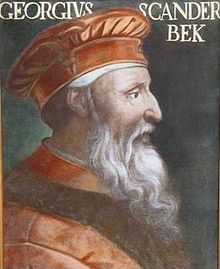

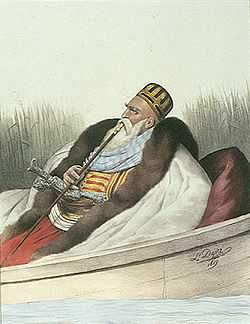
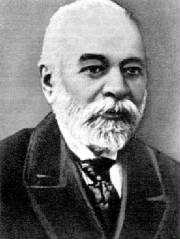
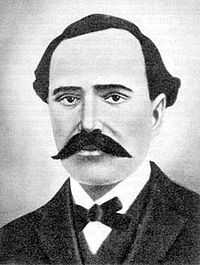


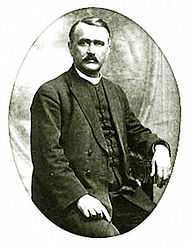
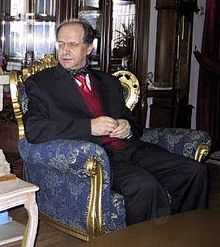
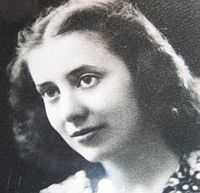
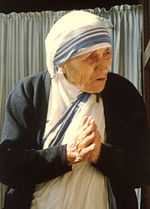

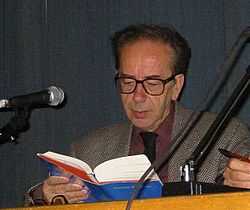
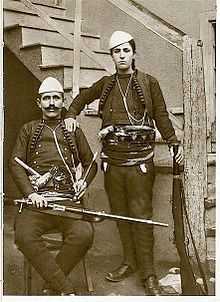
.jpg)
.jpg)
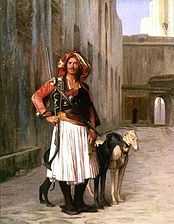
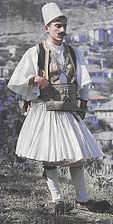
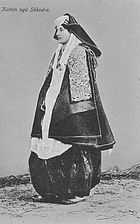
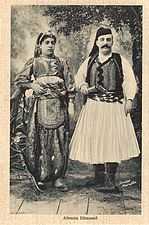
.jpg)


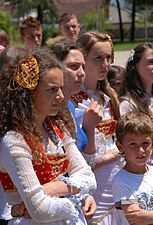
.jpg)
